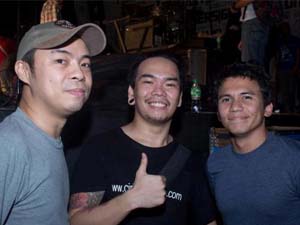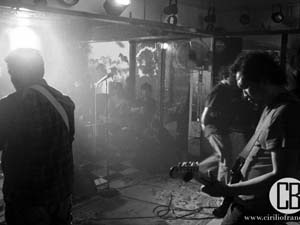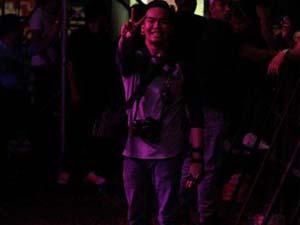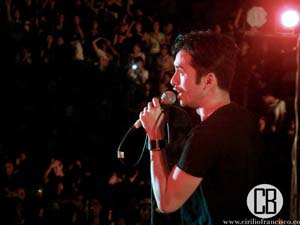
Sidestage shot with the vox. Cyril with Chito Miranda of Parokya ni Edgar and Yael Yuzon of Spongecola during the celebration of UP Fair 2013
Falling for two loves and not having the freedom to choose both is one of the many tragedies of life. Just think of all the songs that have lamented over this regrettable predicament and how it drove many lovers to the edge of despair – if not the brink of insanity.
Such has been the fate of many of those who dared to fall in love twice that it seems unthinkable that someone like Cyril Franz Borgonia, a music photographer who’s been touring the country to film some of the biggest and rising music personalities in the local music industry, can equally pursue the two greatest loves of his life and live to tell about it.
This week, let’s hear him out as he talks about the joys, the quirks, challenges, and rewards of being a freelance music photographer.
When did you start to take an active interest in photography?
We’ve always had cameras in our house, so I’ve always been interested in taking pictures since I was a kid although they were mostly random shots of things that caught my interest at first. When I got into college, I joined our campus publication as a photojournalist. They organized a crash course for us, and that’s when I started taking photography more seriously.
Which among the projects that you worked on made you think that “Ahh… this is the thing that I want to do for the rest of my life?
Probably the shots I took from Rugis’ concert several years back. I’ve been taking pictures for some time then, but I haven’t given specializing in music photography much thought yet. I took several shots of the band while performing like usual, but after I got the prints, I was amazed at how a single, well-taken shot can define an entire performance. When I realized that, I decided that that’s what I want to be – someone who can take photos powerful enough to make people feel as if they were at the front row – watching the event themselves.
Did you have any formal training in photography?
I took this crash course on basic photography when I was in college, then I attended a workshop conducted by Ms. Niña Sandejas on music photography, gig shoots, basic post-processing techniques, and photography do’s and don’ts. The rest, I learned from experience.
When did you start freelancing as a photographer?
Around 2010, after I got my first DSLR camera. Before that, I had to make do with a simple point and shoot camera, so there were limits on the kinds of shots that I can take. After I got my DSLR, I was able to experiment with different shots – allowing me to accept more projects.
How is it like to be a music photographer? Do you get commissioned to take photos of events, are you invited to take photos for free, or do you just attend them and take pictures while you’re watching?
It varies. Taking pictures are prohibited at some events, so when we were starting out, my friends and I had to resort to what we call “ninja moves” to get some shots. Sometimes, we’d get caught and kicked out of the event; sometimes we’d get away with it.
When I began meeting more people with notable connections, I started to receive invitations from event organizers to take photos. Sometimes they pay us to do it, sometimes they’d give us freebies for our efforts.
Sometimes, I also contact artists myself to ask them if I can take photos at their concerts.
It varies. Taking pictures are prohibited at some events, so when we were starting out, my friends and I had to resort to what we call “ninja moves” to get some shots. Sometimes, we’d get caught and get kicked out of the event; sometimes we’d get away with it.
When I began meeting more people with notable connections, I started to receive invitations from event organizers to take photos. Sometimes they pay us to do it, sometimes they’d give us freebies for our efforts.
Sometimes, I also contact artists myself to ask them if I can take photos at their concerts.
Do you ever feel frustrated about not being paid for some of the photos that you take considering you’re already working as a freelance photographer?
Not really. Of course, it’s always nice to earn some extra money here and some extra money there, but at the end of the day, I’m first and foremost a photographer. I find pleasure in taking pictures, and that’s the most important thing.
Covering events is also a good way to gain connections, so the people that you might meet later could compensate for the money that you may not earn now.
Besides, just being able to see how these incredibly talented artists are like backstage — minus the spotlights and all — is already very rewarding in itself.
Being a part-fan and part-photographer, do you still get to enjoy performances considering that you have to wait on standby to take that one perfect shot?
Yes, I do. I have to admit that I can’t give them my full attention, but I’ve found ways to manage it. For example, the best moments usually happen either at the beginning or at the end of performances, so I’d be snapping pictures with my camera during those times. After I’ve gotten a few shots that I think I can use, I’d go back to enjoying the concert.
Now that you are a freelance photographer, have you encountered things that you would never have imagined when you were still just starting out?
I didn’t know I would get to meet a lot of great people and travel to wonderful places while doing what I love. I thought when you’re a photographer, you’ll just be there to take shots, but, so far, my work has allowed me to forge relationships with people that I might not have met if I have pursued a different career.
I guess the only downside is when you’re at work, you’ll be expected to maintain a certain level of professionalism, so that means not taking selfies while covering events or rushing backstage for a photo op with your idol for your next profile picture on Facebook. That’s usually reserved for the afterparty – if there would be enough time for one. Imagine how that feels like for a fan.
Aside from music photography, is there any other particular genre that you wish to explore in the future or a specific technique that you wish to improve on?
I’m really passionate about food, so I would love to do food photography given the opportunity. The equipment it requires is a bit expensive, though, so I have to save up some money first.
Skillswise, I hope to establish my own style. Right now, I’m trying to differentiate myself from other concert photographers by writing accompanying articles for the pictures that I take, so I’m working on improving my writing abilities.
On average, how many shots do you usually take during the events that you cover?
More than a thousand, I think. I would then narrow them down to around 120 until they’re finally down to around 30 of the best shots. It depends on how many artists performed in the event.
What do you consider to be the highlights of your career so far?
Covering Rico Blanco’s concert. It was my first time to take photos of a high-profile musician, so it was both nerve-racking and exciting at the same time. The same goes for the concert of Parokya ni Edgar in Southern Luzon State University.
Another one was when my website was finally launched. The site has been a big help in introducing my work to more people, so I’m trying my best to keep it updated in spite of my busy schedule.
If you can take a photo of one particular person or one particular moment, who or which would it be?
If I would have to choose, my ultimate dream would be to take band portraits of either Foo Fighters or Eraserheads.
Also, it’s always been one of my goals to capture Ian Tayao’s (Wilabaliw, Queso) backflip and Marc Abaya’s (Kjwan) water stunt. Hopefully, I can do all of them soon.
Do you have any tips or advice for people who are interested in pursuing the same thing that you did?
If possible, start from scratch then work your way to the top. It might take longer, but it will give you the opportunity to work with and learn from different people.
If you really want it, go for it. There’s no harm in trying, but make sure you’re also prepared to work for it. Photography is not all fun and games. You might encounter some challenges along the way, but once you’ve managed to strike a balance between work and play, it’s one of the most rewarding professions out there.
Do you have any present or upcoming projects that you’d want other people to check out or watch out for?
Yes. If you have some time, do visit our exhibit at Sadik Grill at Trinidad corner Osmeña Streets, near Ground Zero Pizza Place. We’re also working on the music video of a certain rapper whose name we can’t disclose yet, so please watch out for it.
If you have an Instagram account, you can also check out more of my stuff at @sighreel by using the #cbphotos, #musicinaframe, #cbprojects hashtags.
Thanks, guys!
🙂





 Philippine Peso
Philippine Peso